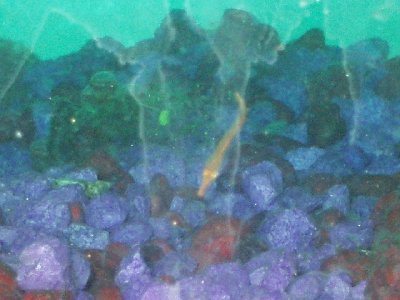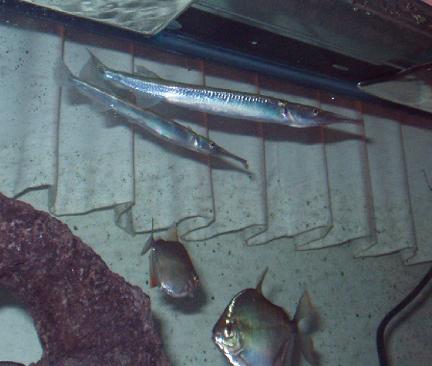Page 4

baby gar a few days after hatching
We seperate our eggs as soon as possible to keep the other fish from devouring them, also because we believe the smaller the hatchery, the better chance the fry have of finding their food source(s). We place them in a 10 gallon tank, set up with water from the parent tank so as to keep the same PH levels etc. We also add an additive to keep any fungus from the unfertilized eggs, which turn white after a few days, from spreading to good eggs and distroying potential fry. Trying to find food for the tiny fry to eat has been quite a challenge. We have decided upon, liquid fry for the babies as soon as they hatch, or infusoria. Both of these have microbes which the tiny little guys can eat at birth. We actually use a combination of both every four hours, in conjunction with other foods, to follow. Newly hatched sanfrancisco brine shrimp are also added, 1 tsp rinsed thoroughly to remove the salt, every four hours. (this means 1 tsp of nothing but shrimp. we drain ours from the shrimp hatchery in a net, making sure the amout after drainage and rinsing, is equal to 1 tsp of shrimp, or there abouts.) We leave the shrimp in the net and place it in a cup of water from the tank (still in the net), with a cube of frozen daphnias (under the net, in the cup of water) (live work best but its winter time and we are unable to find any) in the cup to thaw. It is our hope that the daphnia will smell or taste like the shrimp and they will also consume them even though they are not live prey. Whether or not fish can taste or smell is beyond our knowledge, we are simply making a guess here.
The adult Gar can become very territorial if their environment becomes crowded, and will attack one another in an attempt to establish territorial rights. We added another rock to our aquarium and the usually docile male attacked the female for days in an attempt to establish his own territorial boundaries. Once we removed the rock, things went back to normal.
Gar are very fragile yet resiliant fish. Our male has constantly banged his beak into the glass sides of the tank since he was small, consequently deforming his face. He recently broke off a piece of his lower jaw this way, thus removing his previous deformity but shortening his lower jaw significantly. We feared he might die from the pain, stress or trauma of his accident, but there being nothing we could do, we simply watched and waited. NEVER ATTEMPT TO REMOVE AN INJURED PART OF YOUR FISH. THIS COULD CAUSE MORE HARM THAN GOOD. LET NATURE TAKE ITS COURSE. Within hours he had removed the broken portion of his jaw and was breathing normally. During his duress, the female hovered close to him, placing her body between him and any other fish that came close. (as a general rule the mating pair remain close at all times) It has been a week now since his accident and although we have not seen him eat, we have witnessed him catch a fish. Unfortunately, the female took it away from him (remember she is the dominant one of the pair). We are still watching to see if he will eat.
These fish are very aggressive and will have their spats from time to time, our male has a few scars on his back from where the female used her sharp teeth on him in an attempt to get her way. Sometimes these spats will occur because she is tired of having him hover over her but as a rule they appear to be very affectionate and only fight over food and teritorial disputes.
On a final note, we do not recommend placing bala sharks in the tank with this species of fish. Our female for some reason dislikes them and has killed three. As to whether or not other Gar feel the same way we do not know.
Please feel free to email us with questions, comments or your own observances at Raven's e-mail or Brad's e-mail and thank you for taking the time to read our website.
